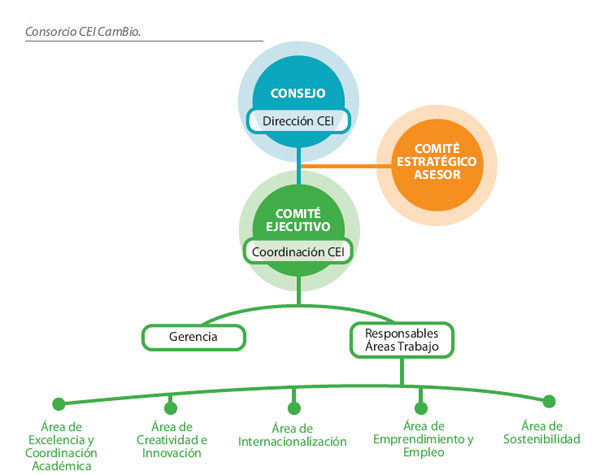GOVERNANCE MODEL
The strategy for the improvement and modernisation of Spanish universities set forth in Estrategia Universidad 2015 is not only linked with the improvement of research and teaching standards -aimed at the increase of the EEES’s competitiveness at the international level- but also with the transformation of governance models. The referential document in this regard, co-produced by CRUE and Fundación CYD, highlights the need to increase flexibility and to strengthen the relationship between the university and society, deploring the excess of bureaucracy and the superabundance of collective bodies.
Along these lines, CEI CamBio suggests the creation of a Consortium, divided into three executive and management bodies formed by a limited number of members, something which is achievable as there is no attempt to have all members represented in a strictly proportional manner. This structure goes beyond traditional university management models. These bodies will hold executive power, on the basis of transparent information and the application of tools and methodologies to encourage a wider involvement.
This wider involvement in decision making processes, and executive accountability are equally important. Directors and managers will have to account for and, given the case, take responsibility for their actions, preventing individual behaviours that could in any way damage the organisation or which are against its values and principles
It is important to highlight that CEI CamBio has already started the bureaucratic steps necessary for the construction of a fully constituted Consortium, through the endorsement of the Agreement for the Constitution of the Consortium CEI CamBio, and Articles of Association.

In order to ensure that the Consortium works in an efficient and flexible way, CEI CamBio’s governance structure will be limited to three executive and management bodies (see Figure 38):
- Steering Committee: the main governing body, under the presidency of the Director and including all participating agents, which will intervene in decision making processes through a vote. The value of each agent’s vote will be estimated in relation to their degree of participation in the CEI’s strategy or of their financial involvement.The Direction of the Consortium will be held by an internationally prestigious personality with a wide experience in management. The position will be advertised in an international call on a competitive basis. CEI CamBio’s director will have ample executive powers for a minimum term of two years, extendable for two further years to a total of four.All partner universities are committed to concede the Consortium the necessary powers for the development of the Strategic Plan 2012-2016 and to facilitate the participation of private firms and other partners, to ensure that CamBio works as a true coalition.This body will not include the chancellors of the partner universities to avoid burdening decision making processes. The universities will nevertheless be proportionally represented, to ensure that an adequate balance is kept with regards to other members, such as public research bodies, corporations and research and technological centres, scientific parks, public administrations, private firms, socio-economic agents, etc.
The main task of the Steering Committee is that of approving and monitoring the CEI CamBio’s Strategic Plan, with the advice of the Comité Estratégico Asesor, and of promoting the capture of external funds.
- Executive Committee: under the presidency of the Coordinator who will report to the Steering Committee. The Coordinator will be appointed by the chancellors of the member universities. This Executive Committee will also include the Manager, and the Head of Area, as defined in the CEI’s strategy.The Manager will be a personality with a wide experience in university management and high level administrative qualifications. The Manager will be responsible for budget management and spending, external contracting and audits, and will also advise the CEI’s Coordinator and Director regarding the capture of external funds.The Heads of Area -(i) Excellence and Academic Coordination, (ii) Creativity and Innovation, (iii) Internationalisation, (iv) Entrepreneurship and Employment, (v) Sustainability- will be appointed by the chancellors of member universities, with the participation of the Coordinator of the Executive Committee.The Committee, along with the Areas, will be responsible for the development and implementation of the actions defined in the Strategic Plan.
- Advisory Strategic Committee:including external experts of international prestige, whose tasks will be to analyse the Plan Estratégico and its future developments. This Committee can, in coordination with the Director and the Coordinator, order experts or specialised firms to elaborate reports regarding future perspectives, trends, ethical implications, internationalisation, etc., from which to forecast long term scenarios for adapting the strategy of CEI CamBio to a changing environment. The members of this committee will act independently to the organisation from which they originate.
The structure of the Consortium CEI CamBio and the agile management structure here suggested respond to the need to increase the flexibility and adaptability of the project and the Strategic Plan 2012-2016, and to our own definition of the ‘ecosystem CEI CamBio’. In this sense, the Consortium will become the forum for the active participation of national and international coalition members, grouped around the Area-specific clusters, reinforcing the feeling of membership and encouraging the utmost involvement with the project.

The governance model presented in this document is the result of the deep revision which the model suggested in 2010 has been subjected to. Although the creation of a Consortium was already suggested in 2010, the large number of member universities and the recent re-definition of the strategic coalition has prompted us to simplify the internal structure of said Consortium, advance in the cession of powers by member universities, and strengthen the management and executive powers of the three bodies included in the Consortium.

